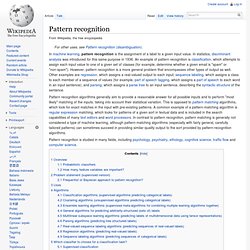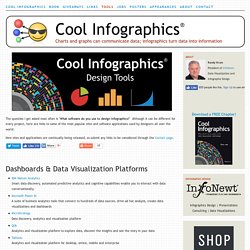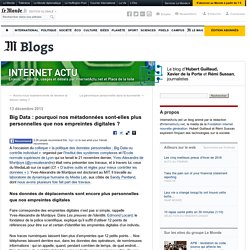Data & Visualisation
Research
Pattern recognition. Pattern recognition algorithms generally aim to provide a reasonable answer for all possible inputs and to perform "most likely" matching of the inputs, taking into account their statistical variation.

This is opposed to pattern matching algorithms, which look for exact matches in the input with pre-existing patterns. A common example of a pattern-matching algorithm is regular expression matching, which looks for patterns of a given sort in textual data and is included in the search capabilities of many text editors and word processors. In contrast to pattern recognition, pattern matching is generally not considered a type of machine learning, although pattern-matching algorithms (especially with fairly general, carefully tailored patterns) can sometimes succeed in providing similar-quality output to the sort provided by pattern-recognition algorithms.
Overview[edit] Probabilistic classifiers[edit] They output a confidence value associated with their choice. . To output labels . .
Tools - Cool Infographics. Adioma creates information graphics out of your textual data, using timelines, grids and icons.

Create impressive charts from spreadsheets. Assemble into dashboards, embed in websites, or simply share a link. A Python interactive visualization library that targets modern web browsers for presentation Cacoo is a free online drawing tool that allows you to create a variety of diagrams such as site map, flowchart, mind map, wire frame, UML diagram and network diagram. Crowdsourced Analytics Solution Marketplace - Make Sense of Big Data Free interactive charts created online in seconds ChartGo is an online graph maker tool. Simply choose your settings, enter your data and hit create.
Visual Thinking. Buckminster Fuller. Data Technology. 3-Visualizations & mapping. DATAJOURNALISM. Realtime & crowdsourced maps.
Excel & Google Spreadsheet. Infographics. Dataviz Tutorials. Dataviz Art. Blogs. Theory. Surveys & Questionaries. Data. Statistics how to. Visual Literacy: An E-Learning Tutorial on Visualization for Communication, Engineering and Business.
Visual Cards for Collaboration and Team Creativity Making the Complex Clear Visual Literacy for Managers - How Sketching enables Visual Problem Solving and Communication (get the hardcopy edition at sketchingatwork.com) By clicking on a map or diagram thumbnail below, you can access an interactive graphic overview on tools, books, researchers in different visualization fields, as well as on key success factors of visualization.

There is also an interactive organizing table that shows (incl. examples) one hundred visualization-based methods. Clicking on a particular tool, book, person, document, principle or method within a map opens the respective website or homepage in a new browser window or reveals an example (most maps were created with lets-focus). Stairs to visual excellence "Towards A Periodic Table of Visualization Methods for Management"Lengler R., Eppler M. (2007). Version 1.5 of the periodic table as PDF Imperfect Storm (Click on image to enlarge)
Wizualizacja sztuki. Big Data: why is metadata more personal than our fingerprints. A l’occasion du colloque « la politique des données personnelles : Big Data ou contrôle individuel « organisé par l’Institut des systèmes complexes et l’Ecole normale supérieure de Lyon qui se tenait le 21 novembre dernier, Yves-Alexandre de Montjoye (@yvesalexandre) était venu présenter ses travaux, et à travers lui, ceux du MediaLab sur ce sujet (Cf. « D’autres outils et règles pour mieux contrôler les données » ).

Yves-Alexandre de Montjoye est doctorant au MIT. Il travaille au laboratoire de dynamique humaine du Media Lab, aux côtés de Sandy Pentland, dont nous avons plusieurs fois fait part des travaux. Nos données de déplacements sont encore plus personnelles que nos empreintes digitales Faire correspondre des empreintes digitales n’est pas si simple, rappelle Yves-Alexandre de Montjoye. Image : illustration de l’unicité de nos parcours repérés via des antennes mobiles. Et Yves-Alexandre de nous inviter à retrouver un de ses collègues du Media Lab. Hubert Guillaud. Visual Thinking Archive - an album on Flickr.




